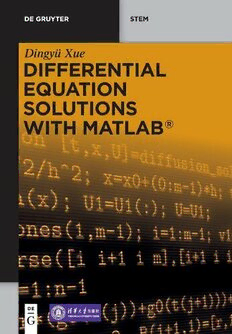Table Of ContentDingyüXue
DifferentialEquationSolutionswithMATLAB®
Also of Interest
Fractional-OrderControlSystems,FundamentalsandNumerical
Implementations
DingyüXue,2017
ISBN978-3-11-049999-5,e-ISBN(PDF)978-3-11-049797-7,
e-ISBN(EPUB)978-3-11-049719-9
CalculusProblemSolutionswithMATLAB®
DingyüXue,2020
ISBN978-3-11-066362-4,e-ISBN(PDF)978-3-11-066697-7,
e-ISBN(EPUB)978-3-11-066375-4
MATLAB®Programming,MathematicalProblemSolutions
DingyüXue,2020
ISBN978-3-11-066356-3,e-ISBN(PDF)978-3-11-066695-3,
e-ISBN(EPUB)978-3-11-066370-9
LinearAlgebraandMatrixComputationswithMATLAB®
DingyüXue,2020
ISBN978-3-11-066363-1,e-ISBN(PDF)978-3-11-066699-1,
e-ISBN(EPUB)978-3-11-066371-6
SolvingOptimizationProblemswithMATLAB®
DingyüXue,2020
ISBN978-3-11-066364-8,e-ISBN(PDF)978-3-11-066701-1,
e-ISBN(EPUB)978-3-11-066369-3
Dingyü Xue
Differential
Equation Solutions
®
with MATLAB
|
Author
Prof.DingyüXue
SchoolofInformationScienceandEngineering
NortheasternUniversity
WenhuaRoad3rdStreet
110819Shenyang
China
[email protected]
MATLABandSimulinkareregisteredtrademarksofTheMathWorks,Inc.Seewww.mathworks.com/
trademarksforalistofadditionaltrademarks.TheMathWorksPublisherLogoidentifiesbooksthat
containMATLABandSimulinkcontent.Usedwithpermission.TheMathWorksdoesnotwarrantthe
accuracyofthetextorexercisesinthisbook.Thisbook’suseordiscussionofMATLABandSimulink
softwareorrelatedproductsdoesnotconstituteendorsementorsponsorshipbyTheMathWorksof
aparticularuseoftheMATLABandSimulinksoftwareorrelatedproducts.ForMATLAB®and
Simulink®productinformation,orinformationonotherrelatedproducts,pleasecontact:
TheMathWorks,Inc.
3AppleHillDrive
Natick,MA,01760-2098USA
Tel:508-647-700
Fax:508-647-7001
E-mail:[email protected]
Web:www.mathworks.com
ISBN978-3-11-067524-5
e-ISBN(PDF)978-3-11-067525-2
e-ISBN(EPUB)978-3-11-067531-3
LibraryofCongressControlNumber:2020931439
BibliographicinformationpublishedbytheDeutscheNationalbibliothek
TheDeutscheNationalbibliothekliststhispublicationintheDeutscheNationalbibliografie;
detailedbibliographicdataareavailableontheInternetathttp://dnb.dnb.de.
©2020TsinghuaUniversityPressLimitedandWalterdeGruyterGmbH,Berlin/Boston
Coverimage:DingyüXue
Typesetting:VTeXUAB,Lithuania
Printingandbinding:CPIbooksGmbH,Leck
www.degruyter.com
Preface
Scientificcomputingiscommonlyandinevitablyencounteredincourselearning,sci-
entificresearchandengineeringpracticeforeachscientificandengineeringstudent
andresearcher.Forthestudentsandresearchersinthedisciplineswhicharenotpure
mathematics,itisusuallynotawisethingtolearnthoroughlylow-leveldetailsofre-
latedmathematicalproblems,andalsoitisnotasimplethingtofindsolutionsofcom-
plicatedproblemsbyhand.Itisaneffectivewaytotacklescientificproblems,with
highefficiencyandin accurateand creativemanner,withthe mostadvancedcom-
putertools.Thismethodisespeciallyusefulinsatisfyingtheneedsforthoseinthe
areaofscienceandengineering.
Theauthorhadmadesomeefforttowardsthisgoalbyaddressingdirectlytheso-
lutionmethodsforvariousbranchesinmathematicsinasinglebook.Suchabook,
entitled“MATLABbasedsolutionstoadvancedappliedmathematics”,waspublished
firstin2004byTsinghuaUniversityPress.Severalneweditionswerepublishedafter-
wards:in2015,thesecondeditioninEnglishbyCRCPress,andin2018,thefourth
editioninChinesewerepublished.BasedonthelatestChineseedition,abrandnew
MOOCprojectwasreleasedin2018,1 andreceivedsignificantattention.Thenumber
ofregisteredstudentswasaround14000inthefirstroundoftheMOOCcourse,and
reachedtensofthousandsinlaterrounds.Thetextbookhasbeencitedtensofthou-
sandstimesbyjournalpapers,books,anddegreetheses.
Theauthorhasover30yearsofextensiveexperienceofusingMATLABinscientific
researchandeducation.Significantamountofmaterialsandfirst-handknowledgehas
beenaccumulated,whichcannotbecoveredinasinglebook.Aseriesentitled“Profes-
sorXueDingyü’sLectureHall”ofsuchworksarescheduledwithTsinghuaUniversity
Press,andtheEnglisheditionsareincludedintheDGSTEMserieswithDeGruyter.
Thesebooksareintendedtoprovidesystematic,extensiveanddeepexplorationsin
scientificcomputingskillswiththeuseofMATLABandrelatedtools.Theauthorwants
toexpresshissinceregratitudetohissupervisor,ProfessorDerekAthertonofSussex
University,whofirstbroughthimintotheparadiseofMATLAB.
TheMATLABseriesisnotasimplerevisionoftheexistingbooks.Withdecadesof
experienceandmaterialaccumulation,theideaof“revisiting”isadoptedinauthor-
ingtheseries,incontrasttoothermathematicsandotherMATLAB-richbooks.The
viewpointofanengineeringprofessorisestablishedandthefocusinonsolvingvar-
iousappliedmathematicalproblemswithtools.Manyinnovativeskillsandgeneral-
purposesolversareprovidedtosolveproblemswithMATLAB,whichisnotpossible
byanyotherexistingsolvers,soastobetterillustratetheapplicationsofcomputer
toolsinsolvingmathematicalproblemsineverymathematicsbranch.Italsohelps
thereadersbroadentheirviewpointsinsolvingscientificcomputing,andevenfind
1 MOOCaddress:https://www.icourse163.org/learn/NEU-1002660001
https://doi.org/10.1515/9783110675252-201
VI | Preface
innovativesolutionsbythemselvestoscientificcomputingwhichcannotbesolvedby
anyotherexistingmethods.
ThefirsttitleintheMATLABseries,“MATLABProgramming”,canbeusedasan
entry-level textbook or reference book to MATLAB programming, so as to establish
asolidfoundationanddeepunderstandingfortheapplicationofMATLABinscien-
tificcomputing.Eachsubsequentvolumetriestocoverabranchortopicinmathe-
maticalcourses.Bearinginmindthe“computationalthinking”inauthoringthese-
ries,deepunderstandingandexplorationsaremadeforeachmathematicsbranchin-
volved.TheseMATLABbooksaresuitableforthereaderswhohavealreadylearntthe
relatedmathematicalcourses,andrevisitthecoursestolearnhowtosolvetheprob-
lemsbyusingcomputertools.Itcanalsobeusedasacompanioninsynchronizing
thelearningofrelatedmathematicscourses,andviewingthecoursefromadifferent
angle,sothatthereadersmayexpandtheirknowledgeinlearningtherelatedcourses,
soastobetterlearn,understandandpracticethematerialsinthecourses.
ThisbookisthefifthoneintheMATLABseriesandfullydevotedtothesolutions
of various differential equations, with extensive use of MATLAB. The analytical so-
lutionsofordinarydifferentialequationsarestudiedfirst,followedbynumericalso-
lutionstoinitialvalueproblemsofvariousordinarydifferentialequations,including
conventionalandspecialequations,delaydifferentialequations,andfractionaldif-
ferentialequations.Somepropertyanalysistasksarealsocoveredinthisbook,and
blockdiagram-basedpatternstovariousdifferentialequationsareaddressed.Discus-
sionsarealsomadetothenumericalsolutionapproachestoboundaryvalueproblems
andpartialdifferentialequations.
Atthetimethebooksarepublished,theauthorwishestoexpresshissinceregrati-
tudetohiswife,ProfessorYangJun.Herloveandselflesscareoverthedecadesprovide
theauthorimmensepower,whichsupportstheauthors’academicresearch,teaching,
andwriting.
September2019 XueDingyü
Contents
Preface|V
1 Anintroductiontodifferentialequations|1
1.1 Introductiontodifferentialequationmodeling|1
1.1.1 Modelingofanelectriccircuit|1
1.1.2 Modelinginmechanicalsystems|3
1.1.3 Modelsinsocialsystems|4
1.2 Abriefhistoryofdifferentialequations|6
1.3 Outlineandmaintopicsinthebook|8
1.4 Exercises|10
2 Analyticalsolutionsofordinarydifferentialequations|11
2.1 Analyticalsolutionsoffirst-orderdifferentialequations|11
2.1.1 Differentialequationsolvablebysimpleintegrals|12
2.1.2 Homogeneousdifferentialequations|13
2.1.3 Inhomogeneouslineardifferentialequations|14
2.1.4 Nonlineardifferentialequationswithseparablevariables|15
2.2 Specialfunctionsandsecond-orderdifferentialequations|17
2.2.1 Gammafunction|17
2.2.2 Hypergeometricfunctions|19
2.2.3 Besseldifferentialequations|20
2.2.4 Legendredifferentialequationsandfunctions|22
2.2.5 Airyfunctions|23
2.3 Solutionsoflineardifferentialequationswithconstant
coefficients|25
2.3.1 Mathematicalmodelingoflinearconstant-coefficientdifferential
equations|25
2.3.2 Laplacetransform-basedsolutions|26
2.3.3 Solutionsofinhomogeneousdifferentialequations|28
2.3.4 Solutionsofdifferentialequationswithnonzeroinitialvalues|29
2.4 Analyticalsolutionsofordinarydifferentialequations|32
2.4.1 Analyticalsolutionsofsimpledifferentialequations|32
2.4.2 Analyticalsolutionsofhigh-orderlineardifferentialequationswith
constantcoefficients|35
2.4.3 Analyticalsolutionsoflineartime-varyingdifferentialequations|38
2.4.4 Solutionsoftime-varyingdifferentialequationsets|40
2.4.5 Solutionsofboundaryvalueproblems|41
2.5 Solutionsoflinearmatrixdifferentialequations|42
2.5.1 Analyticalsolutionsoflinearstatespaceequations|43
2.5.2 Directsolutionsofstatespacemodels|45
VIII | Contents
2.5.3 SolutionofSylvesterdifferentialequation|46
2.5.4 Kroneckerproduct-basedsolutionsofSylvesterdifferential
equations|47
2.6 Analyticalsolutionstospecialnonlineardifferentialequations|48
2.6.1 Solvablenonlineardifferentialequations|48
2.6.2 Nonlineardifferentialequationswhereanalyticalsolutionsarenot
available|50
2.7 Exercises|51
3 Initialvalueproblems|55
3.1 Initialvaluedescriptionsforfirst-orderexplicitdifferential
equations|55
3.1.1 Mathematicalformsofinitialvalueproblems|55
3.1.2 Existenceanduniquenessofsolutions|56
3.2 Implementationoffixed-stepnumericalalgorithms|57
3.2.1 Euler’smethod|57
3.2.2 Second-orderRunge–Kuttaalgorithm|60
3.2.3 Fourth-orderRunge–Kuttaalgorithm|62
3.2.4 Gill’salgorithm|64
3.2.5 ThemthorderRunge–Kuttaalgorithm|65
3.2.6 Multistepalgorithmsandimplementation|68
3.3 Variable-stepnumericalalgorithmsandimplementations|70
3.3.1 Measurestoincreaseefficiency|71
3.3.2 Anintroductiontovariable-stepalgorithms|72
3.3.3 The4/5thorderRunge–Kuttavariable-stepalgorithm|73
3.3.4 ThedifferentialequationsolverprovidedinMATLAB|74
3.3.5 Solutionsofdifferentialequationswithadditionalparameters|80
3.3.6 Avoidingtheuseofadditionalparameters|82
3.4 Validationsofnumericalsolutions|83
3.4.1 Validationofthecomputationresults|83
3.4.2 Dynamicmanipulationofintermediateresults|86
3.4.3 Moreaccuratesolvers|87
3.4.4 Step-sizesandfixed-stepdisplay|88
3.4.5 Demonstrationsofhigh-ordernonlineardifferentialequations|91
3.5 Exercises|93
4 Standardformconversionsofordinarydifferentialequations|99
4.1 Conversionmethodforasinglehigh-orderdifferentialequation|99
4.1.1 Conversionofexplicitequations|100
4.1.2 Solutionsoftime-varyingdifferentialequations|104
4.1.3 Singularitiesindifferentialequations|106
4.1.4 Stateaugmentationforconstantparameters|108
Contents | IX
4.2 Conversionsofcomplicatedhigh-orderdifferentialequations|109
4.2.1 Equationscontainingthesquareofthehighest-orderderivative|110
4.2.2 Equationscontainingoddpowers|112
4.2.3 Equationscontainingnonlinearoperations|113
4.3 Conversionsofdifferentialequationsets|114
4.3.1 Simpleexplicitdifferentialequationsets|115
4.3.2 Limitationswithfixed-stepmethods|122
4.3.3 Simpleimplicitdifferentialequations|124
4.3.4 Evenmorecomplicatednonlineardifferentialequations|127
4.4 Conversionsformatrixdifferentialequations|129
4.4.1 Conversionandsolutionsofdifferentialequationsinmatrix
form|129
4.4.2 Sylvesterdifferentialequations|132
4.4.3 Riccatidifferentialequations|133
4.5 ConversionsofaclassofVolterraintegro-differentialequations|135
4.6 Exercises|139
5 Specialdifferentialequations|145
5.1 Stiffdifferentialequations|145
5.1.1 Timeconstantsinlineardifferentialequations|146
5.1.2 Demonstrationsofstiffphenomena|146
5.1.3 Directsolutionofstiffdifferentialequations|149
5.1.4 Stiffnessdetection|152
5.1.5 Fixed-stepsolutionofstiffdifferentialequations|157
5.2 Implicitdifferentialequations|158
5.2.1 Mathematicaldescriptionofimplicitdifferentialequations|159
5.2.2 Consistentinitialvaluetransformation|160
5.2.3 Directsolutionofimplicitdifferentialequations|163
5.2.4 Implicitdifferentialequationswithmultiplesolutions|166
5.3 Differential-algebraicequations|168
5.3.1 Generalformofdifferential-algebraicequations|168
5.3.2 Indicesofdifferential-algebraicequations|169
5.3.3 Semi-explicitdifferential-algebraicequations|169
5.3.4 Limitationsofthedirectsolver|173
5.3.5 Implicitsolversfordifferential-algebraicequations|175
5.3.6 Indexreductionfordifferential-algebraicequations|180
5.4 Switcheddifferentialequations|183
5.4.1 Linearswitcheddifferentialequations|183
5.4.2 Zero-crossingdetectionandeventhandling|185
5.4.3 Nonlinearswitcheddifferentialequations|188
5.4.4 Discontinuousdifferentialequations|190
5.5 Linearstochasticdifferentialequations|191

